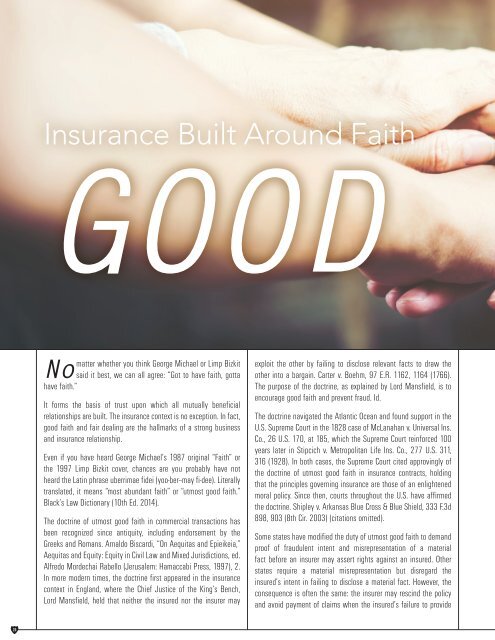ExtraMileIssue11
Create successful ePaper yourself
Turn your PDF publications into a flip-book with our unique Google optimized e-Paper software.
Insurance Built Around Faith<br />
GOOD FAITH<br />
matter whether you think George Michael or Limp Bizkit<br />
No said it best, we can all agree: “Got to have faith, gotta<br />
have faith.”<br />
It forms the basis of trust upon which all mutually beneficial<br />
relationships are built. The insurance context is no exception. In fact,<br />
good faith and fair dealing are the hallmarks of a strong business<br />
and insurance relationship.<br />
Even if you have heard George Michael’s 1987 original “Faith” or<br />
the 1997 Limp Bizkit cover, chances are you probably have not<br />
heard the Latin phrase uberrimae fidei (yoo-ber--may fi-dee). Literally<br />
translated, it means “most abundant faith” or “utmost good faith.”<br />
Black’s Law Dictionary (10th Ed. 2014).<br />
The doctrine of utmost good faith in commercial transactions has<br />
been recognized since antiquity, including endorsement by the<br />
Greeks and Romans. Arnaldo Biscardi, “On Aequitas and Epieikeia,”<br />
Aequitas and Equity: Equity in Civil Law and Mixed Jurisdictions, ed.<br />
Alfredo Mordechai Rabello (Jerusalem: Hamaccabi Press, 1997), 2.<br />
In more modern times, the doctrine first appeared in the insurance<br />
context in England, where the Chief Justice of the King’s Bench,<br />
Lord Mansfield, held that neither the insured nor the insurer may<br />
exploit the other by failing to disclose relevant facts to draw the<br />
other into a bargain. Carter v. Boehm, 97 E.R. 1162, 1164 (1766).<br />
The purpose of the doctrine, as explained by Lord Mansfield, is to<br />
encourage good faith and prevent fraud. Id.<br />
The doctrine navigated the Atlantic Ocean and found support in the<br />
U.S. Supreme Court in the 1828 case of McLanahan v. Universal Ins.<br />
Co., 26 U.S. 170, at 185, which the Supreme Court reinforced 100<br />
years later in Stipcich v. Metropolitan Life Ins. Co., 277 U.S. 311,<br />
316 (1928). In both cases, the Supreme Court cited approvingly of<br />
the doctrine of utmost good faith in insurance contracts, holding<br />
that the principles governing insurance are those of an enlightened<br />
moral policy. Since then, courts throughout the U.S. have affirmed<br />
the doctrine. Shipley v. Arkansas Blue Cross & Blue Shield, 333 F.3d<br />
898, 903 (8th Cir. 2003) (citations omitted).<br />
Some states have modified the duty of utmost good faith to demand<br />
proof of fraudulent intent and misrepresentation of a material<br />
fact before an insurer may assert rights against an insured. Other<br />
states require a material misrepresentation but disregard the<br />
insured’s intent in failing to disclose a material fact. However, the<br />
consequence is often the same: the insurer may rescind the policy<br />
and avoid payment of claims when the insured’s failure to provide<br />
material information had an impact on the nature of the risk.<br />
The foundation of the underwriting process requires an insured<br />
to provide a prospective insurer all facts relevant to the proposed<br />
risk. In commercial transportation property and casualty insurance,<br />
this often requires accurate details of an insured’s assets, revenue<br />
sources, employee count, the number and location of the insured’s<br />
offices, branches, or terminals, miles and routes driven by an<br />
insured’s fleet, management experience and prior claims history,<br />
among other information. When an insured suppresses information<br />
that would have disclosed a different kind of risk than the one<br />
submitted through concealed facts, the insurer may argue that<br />
the insured fraudulently induced it to issue an insurance policy,<br />
affording the insurer the right to void the policy. A leading insurance<br />
treatise asserts that because each party to the insurance contract<br />
is at the mercy of the other, a breach of the special duty of utmost<br />
good faith warrants punishment and deterrence. Couch on Ins. §<br />
198:12 (3d ed. 2001).<br />
Because the consequences of an insured’s failure to abide by the<br />
duty of good faith can be extreme, it is important for applicants<br />
to understand the duty of good faith. Insureds should work closely<br />
with their insurance broker and the underwriter to seek clarification<br />
when a question arises concerning the extent of the disclosures<br />
required or information requested by the underwriter. An open<br />
dialogue and clarification of questions helps avoid situations where<br />
facts are uncovered at the time of loss indicating an insured omitted<br />
important information during the underwriting process.<br />
When parties to an insurance contract are well meaning and<br />
demonstrate good faith by recognizing the special relationship and<br />
obligations owed to one another, the insured obtains the benefits<br />
of the coverage it seeks to protect its assets, reputation and more.<br />
Without good faith, an insured may be exposed to an uninsured, and<br />
unexpected, loss.<br />
The next time you complete an insurance application, it might do<br />
some good to pull out that old cassette tape or CD, turn up the<br />
volume, and play your favorite version of “Faith.” I can just hear<br />
Fred Durst’s earsplitting voice in risk managers’ and brokers’ offices<br />
across the country.<br />
THOMAS J. KING<br />
Corporate Attorney<br />
26<br />
27
















